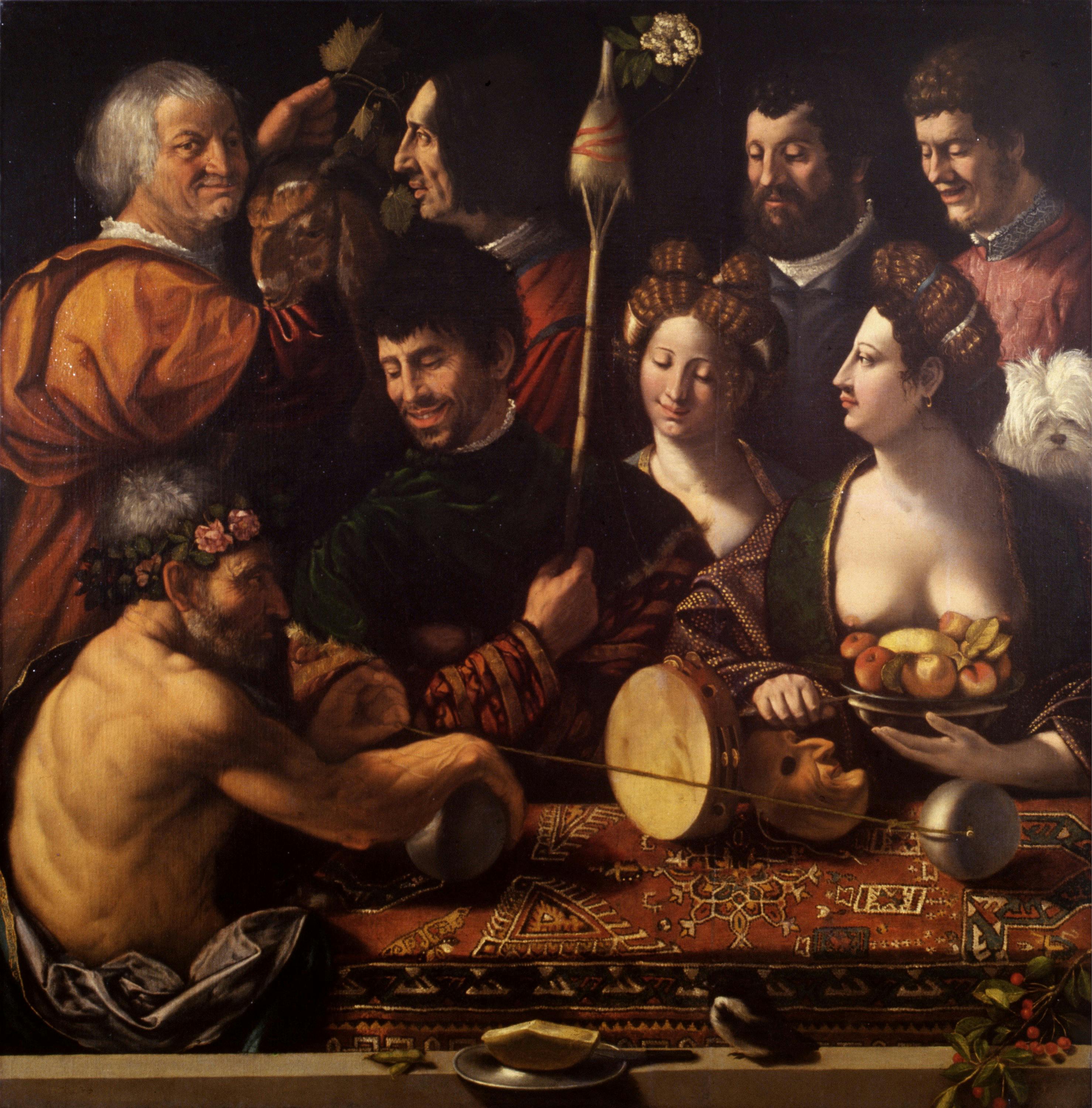Allegory of Hercules
Giovanni di Niccolò Luteri, known as Dosso Dossi (Tramuschio, Modena? circa 1487 - Ferrara 1542); Battista di Niccolò Luteri, known as Battista Dossi (Tramuschio, Modena? doc. from 1517 - Ferrara 1548)
The myth of Hercules was an integral part of the symbolism of power within Renaissance courts and in particular at the Este court, which had two dukes named after the Greek hero: Ercole I (1431-1505) and Ercole II (1508-1559). The famous 'labours' were associated to the qualities needed by a ruler: strength and the ability to overcome adversity, which had to be turned into an opportunity for the prosperity of the ruling family and the state. This work, however, which is among the last paintings by Dosso Dossi (with the possible intervention of his brother Battista Dossi), represents the myth as a parody that opens up several possible interpretations. The hero, instead of performing the famous labours and wearing his classical attributes, such as the cudgel or the lion skin, is depicted as an elderly man: his head is wreathed with roses and he’s playing the game of spheres, a popular pastime in the Este court. Next to him sits a man with ungraceful features, probably a jester, who mocks him while holding a spinning distaff: a reference to Hercules' passion for Omphale, the queen of Lydia, who, according to tradition, kept him with her for a year and forced him to do women's work. Therefore, after so many endeavours, Hercules succumbed to love, inebriated to the point of momentary submission. On the right, a female figure with bare breasts, a basket of fruit in her hand and a mask at her side, symbolises vice; while the girl and the dog in the background, a symbol of fidelity, are a representation of virtue. The objects scattered on the table and on the parapet (the pods, the cheese with the knife, the cherry branches) symbolise the various enjoyments of life, thus creating a complex allegory alluding to the dangers of earthly temptations and erotic pleasures that a wise ruler must be able to moderate for the sake of his state. The four male figures in the upper part of the scene have been interpreted in different ways, that is, from members of the Este family to artists and court jesters.
It is possible that Ercole II d'Este, who probably commissioned the work, wanted a painting of his homonymous hero with desecrating tones, as if to express, by contrast, the wisdom and rectitude of the prince. As a matter of fact, the classic theatrical parodies emphasising the vices from which the ruler had to abstain were highly appreciated at the Este court.
Ercole II probably wanted to reflect in the figure of his mythological namesake his ability to face, with forbearance and patience, the political and religious turmoil within his family: his consort, Renée of France, was a promoter of Calvinist ideas within the court and this contributed to exacerbate the already complicated relations between the Duchy of Este and the Roman Catholic Church.
We must remember how the Este dominion depended on a delicate balance of feudal alliances with the empire and the papacy, which is perhaps symbolised by the spheres with which the hero painted by Dosso is playing. The first sphere, held securely in his right hand, might express the certainty of Ercole II's power over the imperial Duchy of Modena and Reggio, thanks to the investiture renewed by Charles V. The second, controlled with difficulty with the aid of a rope, would then represent the Duchy of Ferrara, which was at the centre of cyclical diatribes with the papacy. As a matter of fact, if in 1539 Ercole II had obtained a temporary confirmation of his power from Paul III against the payment of large sums, a few decades later, when his son Alfonso II died, Ferrara entered the domains of the Church with the Devolution of 1597 (the duke died without legitimate heirs, a condition that allowed Pope Clement VII to annex the duchy to the Papal States). The Este court moved to Modena and many works, including the Allegory of Hercules, were dispersed.
In 1665, the painting was bought from the antiquities market by Cardinal Leopoldo de' Medici, who commissioned the zoomorphic and intertwined frame that still adorns it today. The work was preserved in the Palatine Gallery of Palazzo Pitti and then came to the Uffizi Gallery in 1950.
V. Farinella, “Allegoria di Ercole”, in Ercole il Fondatore dall'antichità al Rinascimento, catalogo della mostra, (Brescia, Museo di Santa Giulia, 11 febbraio – 12 giugno 2011), a cura di M. B. Castellotti e A. Giuliano, Brescia 2011, p. 108-111; A. Pattanaro, Allegoria di Ercole, in Dosso Dossi. Rinascimenti eccentrici al Castello del Buonconsiglio, catalogo della mostra (Trento, Castello del Buonconsiglio, monumenti e collezioni provinciali, 12 luglio – 2 novembre 2014), a cura di V. Farinella, L. Camerlengo, F. De Gramatica, Milano 2014, pp. 224-226; F. De Luca, Allegoria di Ercole, in La città di Ercole. Mitologia e Politica, catalogo della mostra (Firenze, Gallerie degli Uffizi, 20 dicembre 2015 – 31 gennaio 2016), a cura di W.A. Bulst Francesca de Luca, Fabrizio Paolucci, Daniela Parenti, Bologna 2016, pp 140-141; G. Valagussa, Allegoria di Ercole (o Stregoneria?), in Serenissime Trame. Tappeti della Collezione Zalesky e dipinti del Rinascimento, catalogo della mostra (Venezia, Galleria Giorgio Franchetti alla Ca’d’Oro, 23 marzo – 23 luglio 2017) a cura di C. Cremonini, M. Tabibnia, G. Valagussa, Venezia 2017, pp. 170-171; F. Navarro, Allegoria di Ercole, in Leopoldo de' Medici principe dei collezionisti, catalogo della mostra (Firenze, Gallerie degli Uffizi, Palazzo Pitti – Tesoro dei Granduchi, 7 novembre 2017 – 28 gennaio 2018) a cura di V. Conticelli, R. Gennaioli, M. Sframeli, Livorno 2017, pp. 440-441.
